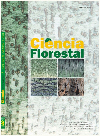
|
Ciência Florestal
Centro de Pesquisas Florestais - CEPEF, Departamento de Ciências Florestais - DCFL, Programa de Pós Graduação em Engenharia Florestal - PPGEF
ISSN: 0103-9954
EISSN: 0103-9954
Vol. 24, No. 4, 2014, pp. 867-873
|
 Bioline Code: cf14082
Bioline Code: cf14082
Full paper language: English
Document type: Research Article
Document available free of charge
|
|
|
Ciência Florestal, Vol. 24, No. 4, 2014, pp. 867-873
| pt |
PREFERÊNCIA DE CORTE DE Acromyrmex crassispinus  (FOREL, 1909) E Acromyrmex ambiguus (FOREL, 1909) E Acromyrmex ambiguus  (EMERY, 1887) (HYMENOPTERA: FORMICIDAE) POR DIFERENTES ESPÉCIES DE EUCALIPTOS EM LABORATÓRIO (EMERY, 1887) (HYMENOPTERA: FORMICIDAE) POR DIFERENTES ESPÉCIES DE EUCALIPTOS EM LABORATÓRIO
Rosado, João Luis Osório; Loeck, Alci Enimar; Freitas, Deise Farias; de Gonçalves, Michel Gonçalves; Dröse, William; da Cunha, Uemerson Silva & Finkenauer, Elder
Resumo
A busca por novos métodos de manejo e controle de formigas-cortadeiras vem sendo enfoque de inúmeros
estudos pelo país, impulsionada por aspectos econômicos e ambientais. O estabelecimento de espécies
resistentes ou menos preferidas ao corte pode contribuir substancialmente neste sentido. Logo, o objetivo
deste estudo foi avaliar a preferência de corte entre as espécies Corymbia citriodora

, Eucalyptus benthamii

,
Eucalyptus camaldulensis

, Eucalyptus dunnii

, Eucalyptus globulus

e híbrido de Eucalyptus urophylla

X Eucalyptus grandis

por Acromyrmex ambiguus

e Acromyrmex crassispinus

em laboratório. Para isso,
folhas foram ofertadas, simultaneamente, para seis colônias de cada espécie em bioensaios com chance
de escolha. No entanto, nos testes sem chance de escolha, apenas as espécies menos preferidas pelo teste
anterior foram utilizadas. Para Acromyrmex crassispinus, as espécies Eucalyptus camaldulensis e híbrido
de Eucalyptus urophylla X Eucalyptus grandis foram mais cortadas, enquanto que as espécies Corymbia
citriodora, Eucalyptus dunnii e Eucalyptus globulus foram menos preferidas ao corte. Acromyrmex
ambiguus apresentou padrão similar de preferência, adicionando-se Eucalyptus benthamii entre as mais
preferidas e excluindo-se Eucalyptus dunnii das menos preferidas.
formigas-cortadeiras; silvicultura; resistência; antixenose
|
| |
| en |
CUTTING PREFERENCE OF Acromyrmex crassispinus  (FOREL, 1909) AND Acromyrmex ambiguus (FOREL, 1909) AND Acromyrmex ambiguus  (EMERY, 1887) (HYMENOPTERA: FORMICIDAE) BY DIFFERENT EUCALYPT SPECIES IN LABORATORY (EMERY, 1887) (HYMENOPTERA: FORMICIDAE) BY DIFFERENT EUCALYPT SPECIES IN LABORATORY
Rosado, João Luis Osório; Loeck, Alci Enimar; Freitas, Deise Farias; de Gonçalves, Michel Gonçalves; Dröse, William; da Cunha, Uemerson Silva & Finkenauer, Elder
Abstract
The search for new leafcutter ant management and control methods have been the aim of several studies
over the country, propelled by economic and environmental aspects. The establishment of resistant or less
preferred species for the cut can contribute substantially in this subject. This way, the objective of this study
was to evaluate the cutting preference between the species Corymbia citriodora

, Eucalyptus benthamii

,
Eucalyptus camaldulensis

, Eucalyptus dunnii

, Eucalyptus globulus

and híbrido de Eucalyptus urophylla

X Eucalyptus grandis

by Acromyrmex ambiguus

and Acromyrmex crassispinus

in laboratory. Therefore, leafs
were offered simultaneously to six colonies of each species in bioassays with chance to choose. However,
in the tests without chance to choose, only the least preferred species in the previous test were utilized. For
Acromyrmex crassispinus, the species Eucalyptus camaldulensis and híbrido de Eucalyptus urophylla X
Eucalyptus grandis were the most cutted, besides Corymbia citriodora, Eucalyptus dunni and Eucalyptus
globules were less preferred. Acromyrmex ambiguus showed similar preference pattern, adding Eucalyptus
benthamii among the most preferred one and excluding Eucalyptus dunnii from the least preferred.
leafcutter ants; silviculture; resistance; antixenose
|
| |
© Copyright 2014 - Ciência Florestal
Alternative site location: http://cascavel.ufsm.br/revistas/ojs-2.2.2/index.php/cienciaflorestal/index
|
|
